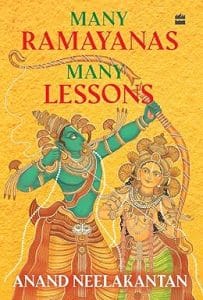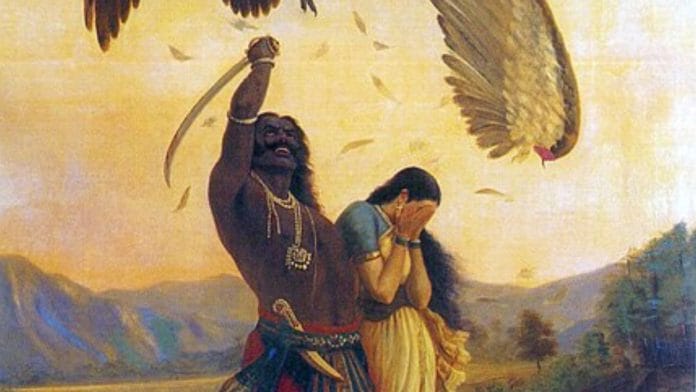In many latter-day versions of the Ramayana, the very idea that Sita was touched by the demon Ravana is horrifying to those immersed in devotion to Rama. Over time, we find the concept of the Ramayana itself undergoing a change. In the original versions, both the Ramayana and its companion epic, the Mahabharata, were tales of karma and its result, the karmaphala. Over time, as the Bhakti cult spread in the medieval period, women’s chastity became a central theme in medieval literature. This period also saw the advent of Islam in India. Contact with Semitic religions influenced storytelling in a fascinating manner.
Medieval poets were uneasy about Ravana touching Sita, which he did when he held her to his side and flew with her to Lanka after the Pushpaka Vimana crashed. We find a curse is added to these Ramayanas, to the effect that if Ravana touched any woman, he would die. In the Valmiki Ramayana, Ravana grabs Sita by the waist. Raja Ravi Varma’s famous painting also depicts this scene.
Valmiki is not uncomfortable with this fact because he lived in a different era. He also shows Ravana in a more positive light because Ravana never forces himself upon Sita. But the moment the curse angle is added, it justifies the vilification of Ravana. We can see how slowly the story turns from a story about karma and karmaphala into a tale of good versus evil. So Ravana no longer has any redeeming qualities. He desists from forcing himself upon Sita not due to any noble intent, or because he knows she is his daughter (according to the folk and Jain versions) but because of the curse upon him.
Also read: Many faces of the Sun: Surya in Hindu and Buddhist traditions
The Concept of Maya-Sita
The touching of Sita by any other male other than Rama, and Rama’s demand after the war that Sita undergo a trial by fire to establish her chastity—since she has lived in another man’s abode for so long—are two of the most uncomfortable events as per many in the Ramayana. The concept of the Maya-Sita very effectively takes care of the discomfort factor in both cases.
As per this concept, the moment Sita crosses the line drawn by Lakshmana—the Lakshmana rekha—she vanishes and a new illusory ‘Maya’ Sita takes her place. Some Ramayanas state that Sita disappears when she sees Ravana in Panchavati, and a Maya-Sita takes her place.
It is this Maya-Sita who is taken away by Ravana.
When Rama, after defeating Ravana, asks Sita to undergo an agnipariksha (trial by fire) ostensibly to prove she is still chaste, it is actually to send this Maya-Sita back to Agni Deva, the God of Fire and allow the real Sita to return. However, in the Uttara Ramayana, Rama asks Sita to undergo a second agnipariksha as well, and there the concept of Maya-Sita is not mentioned.
We see how various authors of the different Ramayanas have tried to interpret and define it according to the ethics and morality of the times and the society they lived in.
As mentioned above, this explanation assuages the discomfort that many Vaishnava- and Rama-devotee poets felt and feel on reading the original Valmiki Ramayana. By creating a Maya-Sita, the demon does not touch Sita, an avatar of Lakshmi, the consort of Vishnu. Secondly, Rama’s insistence on Sita undergoing an agnipariksha is explained away beautifully.
But this does not answer some other questions which arise.
If it was indeed the Maya-Sita whom Ravana kidnapped, then the entire Ramayana becomes meaningless. Why did Rama fight for a Maya-Sita? If it was an illusionary Sita, why was Rama chasing an illusion?
The evil Ravana had already been tricked by the Maya-Sita. So, when Rama returned after killing Mareecha, the real Sita could have easily appeared before him, and everyone would have been happy. Ravana got a Maya-Sita, an illusionary Sita, and Rama had his real Sita. So there was no need to kill Ravana at all, as he had already been tricked. Rama, Sita and Lakshmana could have had a good laugh at Ravana’s expense and gone home to live happily ever after. But if that were so, there would have been no further story. That is why Valmiki did not go down this route.
One of the most important aspects of the Valmiki Ramayana is that he never hides any of Rama’s flaws or mistakes. He is clear that Rama is a human avatar of Vishnu. As no human is perfect, Rama too has his failings. As a storytelling tool, a flawed hero is far more real and fascinating. Hence, Valmiki, the great poet that he was, conceived Rama in this fashion. He could have hidden every wart and mole; why indeed bring in an episode such as the agnipariksha, the trial by fire? Why make his hero suffer by having his wife abducted by Ravana? But Valmiki’s Rama expresses deep anguish like any ordinary mortal. This is one of the most beautiful scenes of the Ramayana, where Rama openly shows his love for Sita. This often happens in our lives too. How often do we take our loved ones for granted? Only when they are absent do we admit how much we love or miss them.
The Maya-Sita concept is a straightforward addition to the Ramayana, introduced by Bhakti-era poets. In versions of the Mahabharata, in the Vishnu Purana, in the Harivamsha Purana, and even in the Kamba Ramayana, which is perhaps the earliest non-Sanskrit classical rendition of the Ramayana, the Maya-Sita concept appears. It is used as a tool to say that Sita remained unblemished. But in the Uttara Ramayana, even this argument falls apart. We will discuss that in greater detail later. The poem ‘Ramacharitamanas’ deals with the problem differently as the saint-poet Tulsidas would have been aware of the flaws in the amended versions.
In the Kamba Ramayana, Ravana scoops up all the ground upon which the ashram is situated, as well as Sita, and places it in the Pushpaka Vimana, when he abducts Sita. This is because Ravana has been cursed that he cannot touch any woman without her consent. Here, the Maya-Sita concept does not exist, but Sage Kamba is nevertheless uncomfortable with another man touching the divine Sita, hence this device. Medieval literature extols the chastity of women and their devotion to their husbands.
The Maya-Sita concept is central to the Rama cult, but not to the Valmiki Ramayana or even the story. Thus, it is contrary to the karma and karmaphala principles of the original Ramayana and sits as an addition that does not really merge with the storyline.
 This excerpt from ‘Many Ramayanas, Many Lessons’ by Anand Neelakantan has been published with permission from HarperCollins Publishers.
This excerpt from ‘Many Ramayanas, Many Lessons’ by Anand Neelakantan has been published with permission from HarperCollins Publishers.






